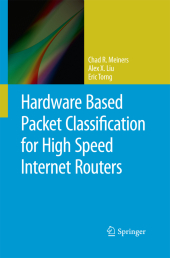 Neuerscheinungen 2014Stand: 2020-02-01 |
Schnellsuche
ISBN/Stichwort/Autor
|
Herderstraße 10
10625 Berlin
Tel.: 030 315 714 16
Fax 030 315 714 14
info@buchspektrum.de |

Alex X. Liu, Chad R. Meiners, Eric Torng
(Beteiligte)
Hardware Based Packet Classification for High Speed Internet Routers
2010. 2014. xiii, 123 S. 235 mm
Verlag/Jahr: SPRINGER, BERLIN; SPRINGER US; SPRINGER 2014
ISBN: 1-489-99954-X (148999954X)
Neue ISBN: 978-1-489-99954-2 (9781489999542)
Preis und Lieferzeit: Bitte klicken
This book presents recent developments in hardware based packet classification algorithms and architectures. It describes five methods that reduce the space that classifiers occupy within TCAMs and includes case studies and examples throughout.
Hardware Based Packet Classification for High Speed Internet Routers presents the most recent developments in hardware based packet classification algorithms and architectures. This book describes five methods which reduce the space that classifiers occupy within TCAMs; TCAM Razor, All-Match Redundancy Removal, Bit Weaving, Sequential Decomposition, and Topological Transformations. These methods demonstrate that in most cases a substantial reduction of space is achieved. Case studies and examples are provided throughout this book.
About this book:
- Presents the only book in the market that exclusively covers hardware based packet classification algorithms and architectures.
- Describes five methods which reduce the space that classifiers occupy within TCAMs: TCAM Razor, All-Match Redundancy Removal, Bit Weaving, Sequential Decomposition, and Topological Transformations.
- Provides case studies and examples throughout.
Hardware Based Packet Classification for High Speed Internet Routers is designed for professionals and researchers who work within the related field of router design. Advanced-level students concentrating on computer science and electrical engineering will also find this book valuable as a text or reference book.
Equivalent Transformation Techniques.- TCAM Razor.- Bit Weaving.- All-Match Redundancy Removal.- Background.- New Architectural Approaches.- Sequential Decomposition.- Topological Transformations.- Related Work.


